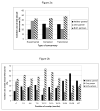Condom use and duration of concurrent partnerships among men in the United States
- PMID: 19265736
- PMCID: PMC2791954
- DOI: 10.1097/OLQ.0b013e318191ba2a
Condom use and duration of concurrent partnerships among men in the United States
Abstract
Objectives: Concurrent partnerships accelerate dissemination of STIs. Most investigations of the features of concurrent partnerships have focused on higher risk subpopulations.
Goal: To assess condom use and the duration of concurrent sexual partnerships among men in the United States.
Study design: Analysis of concurrent sexual partnerships among men in the 2002 National Survey of Family Growth. We classified pairs of concurrent partnerships into 3 types: transitional, contained, and experimental concurrency, and assessed the duration of overlap. We also report the distribution of condom use at the last sexual intercourse with neither, one or both concurrent partners of each pair and characteristics of men more likely to have used condoms with neither sex partner.
Results: The duration of overlap was <1 month in 32%, 1 to 3 months in 19%, and >12 months in 25% of concurrency pairs. Half (55%) of the pairs (whites, 64%; blacks, 41%) involved unprotected sex at the last sexual intercourse with at least 1 partner. The 35% of men who were more likely to use condoms with neither sex partner at the last sexual intercourse were older, white (48%), married/cohabitating (55%), and during the previous 12 months were incarcerated (49%), or used crack/cocaine (51%).
Conclusions: Although blacks generally experience higher rates of STIs and HIV, in this representative sample of men in the United States, blacks in concurrent partnerships seemed to use the only available protection (condoms) against infection (apart from abstinence) more than other racial/ethnic groups. Continued investigation of features of sexual partnership patterns is critical for curbing STI and HIV transmission.
Figures


Similar articles
-
Coparenting and sexual partner concurrency among white, black, and Hispanic men in the United States.Sex Transm Dis. 2011 Apr;38(4):293-8. doi: 10.1097/OLQ.0b013e3181fc7005. Sex Transm Dis. 2011. PMID: 21042233 Free PMC article.
-
Prevalence and correlates of condom use among sexually active men who have sex with men in the United States: findings from the National Survey of Family Growth, 2002, 2006-10 and 2011-13.Sex Health. 2017 Aug;14(4):363-371. doi: 10.1071/SH16034. Sex Health. 2017. PMID: 28591549
-
Heterosexual experiences and partnerships of urban, low-income African-American and Hispanic youth.J Acquir Immune Defic Syndr Hum Retrovirol. 1996 Mar 1;11(3):288-300. doi: 10.1097/00042560-199603010-00009. J Acquir Immune Defic Syndr Hum Retrovirol. 1996. PMID: 8603265
-
High prevalence of sexual concurrency and concurrent unprotected anal intercourse across racial/ethnic groups among a national, Web-based study of men who have sex with men in the United States.Sex Transm Dis. 2012 Oct;39(10):741-6. doi: 10.1097/OLQ.0b013e31825ec09b. Sex Transm Dis. 2012. PMID: 23001260 Free PMC article.
-
Sexual partner concurrency among STI clinic patients with a steady partner: correlates and associations with condom use.Sex Transm Infect. 2009 Sep;85(5):343-7. doi: 10.1136/sti.2009.035758. Epub 2009 Feb 9. Sex Transm Infect. 2009. PMID: 19204019 Free PMC article. Clinical Trial.
Cited by
-
Concurrent sexual partnerships among young heterosexual adults at increased HIV risk: types and characteristics.Sex Transm Dis. 2015 Apr;42(4):180-4. doi: 10.1097/OLQ.0000000000000252. Sex Transm Dis. 2015. PMID: 25763670 Free PMC article.
-
Incarceration and high-risk sex partnerships among men in the United States.J Urban Health. 2009 Jul;86(4):584-601. doi: 10.1007/s11524-009-9348-5. Epub 2009 May 21. J Urban Health. 2009. PMID: 19459050 Free PMC article.
-
Condom use and concurrent partnering among heterosexually active, African American men: a qualitative report.J Urban Health. 2013 Oct;90(5):953-69. doi: 10.1007/s11524-012-9747-x. J Urban Health. 2013. PMID: 22869516 Free PMC article.
-
Characteristics of multiple and concurrent partnerships among women at high risk for HIV infection.J Acquir Immune Defic Syndr. 2014 Jan 1;65(1):99-106. doi: 10.1097/QAI.0b013e3182a9c22a. J Acquir Immune Defic Syndr. 2014. PMID: 24056163 Free PMC article.
-
Examining the Impact of Criminal Justice Involvement on Health Through Federally Funded, National Population-Based Surveys in the United States.Public Health Rep. 2019 May/Jun;134(1_suppl):22S-33S. doi: 10.1177/0033354918824324. Public Health Rep. 2019. PMID: 31059413 Free PMC article. No abstract available.
References
-
- Morris M, Goodreau S, et al. E. Sexual Networks, Concurrency, and STD/HIV (chapter 7) In: Holmes KK, Sparling PF, Piot P, Stamm W, Wasserheit JN, Corey N, Cohen MS, editors. Sexually Transmitted Diseases. New York: McGraw-Hill; 2007.
-
- Morris M, Kretzschmar M. Concurrent partnerships and the transmission dynamics in networks. Social Networks. 1995;17:299–318.
-
- Doherty IA, Minnis A, Auerswald CL, Adimora AA, Padian NS. Concurrent partnerships among adolescents in a Latino community: The Mission District of San Francisco, California. Sex Transm Dis. 2007;34:437–443. - PubMed
-
- Kraut-Becher JR, Aral SO. Gap length: an important factor in sexually transmitted disease transmission. Sex Transm Dis. 2003;30:221–5. - PubMed
-
- Foxman B, Newman M, Percha B, Holmes KK, Aral SO. Measures of sexual partnerships: lengths, gaps, overlaps, and sexually transmitted infection. Sex Transm Dis. 2006;33:209–14. - PubMed
Publication types
MeSH terms
Substances
Grants and funding
LinkOut - more resources
Full Text Sources
Medical

